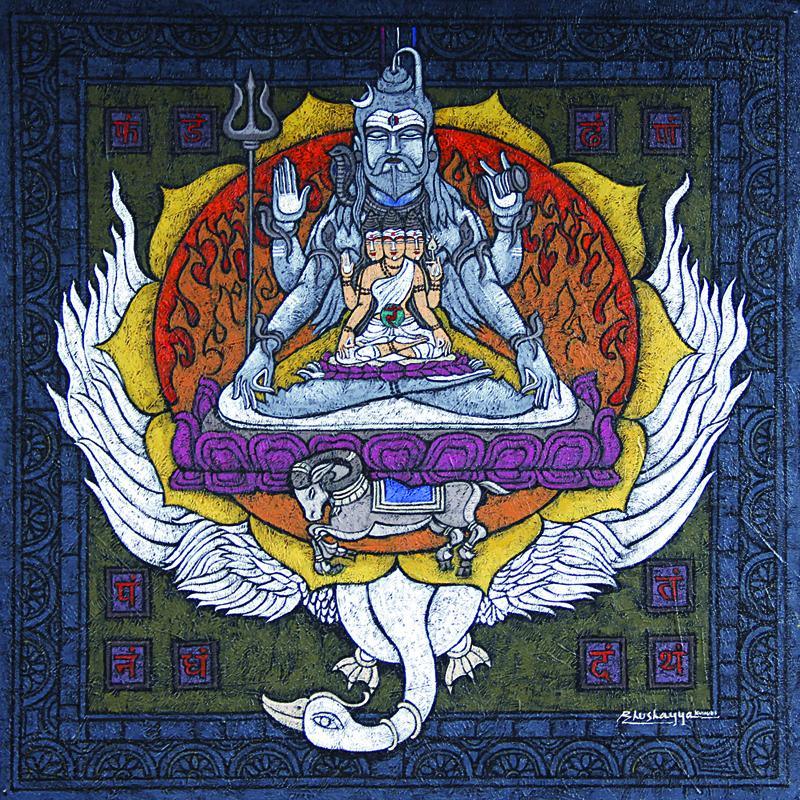
Beatiful art by Kunuu Bhushayya available on Artzolo
Introduction
Muladhara means ‘root support’. Muladhara anchors us to the earth and the world around us. It is stabilizing and grounding. The root chakra is the foundation for the other chakras, so it needs to be strong.
Roots need to be tended and fed well. We need to feed ourselves on wellness and positivity. We need to look after ourselves spiritually, mentally and physically. By drawing vitality up from the earth through Maladhara we can bloom into our full potential, like a lotus flower growing up from the mud on the bottom. A lotus plant uses its roots to extract the nutrition in the mud so it can blossom and form seeds.
Muladhara is located at the base of the spine, the tail bone or perineum. Its exact location is just within the vagina in women and the perineum in men. When you visualize the chakras take your awareness to where you feel the energy.
Muladhara is the seat of kundalini energy, where the snake of kundalini lies dormant coiled three & a half times around the lingam. A lingam is a stylized phallic symbol representing the regenerative powers of Shiva.
The root chakra is the meeting point of the three main nadis, Ida, Pingala and Sushumna with the energy travelling downwards into the earth. This is represented by downward pointing triangle.
The bija mantra of the earth element is LAM. Chanting the mantra for a few minutes’ aids in meditation. The sounds of the petals are vam, sam, sam, sam.
Colours associated with this chakra are red, yellow, and gold.
Muladhara is connected to Annamaya kosha, the body. It is the bliss centre, (it’s where orgasms originate after all). It relates to the physical body, health, survival, fears and family. Also, our material needs, job, shelter, wellness, and security.
Use Muladhara as a way to understand, accept and heal your body. It is the gateway to our inner world.
Deities instilled in the Chakra
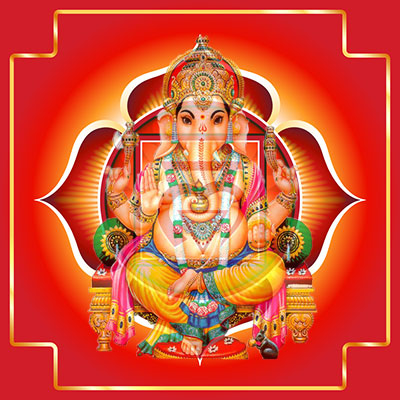
Lord Ganesh is the animal spirit within the chakra. Spirit animals are our protectors. Ganesh symbolizes wisdom, strength, and the ability to overcome challenges. When endeavouring to awaken kundalini energy it is important to have a solid foundation of spiritual study and right living. Ganesh, as the deity who protects the gateway to higher consciousness, is there to ensure that one’s energy is properly grounded before ascending through the chakras.
In Tantra Kundalini the ruling deities of Maladhara are, Indra, the king of the gods, Brahma, the lord of creation, and the female energy is Dakini.
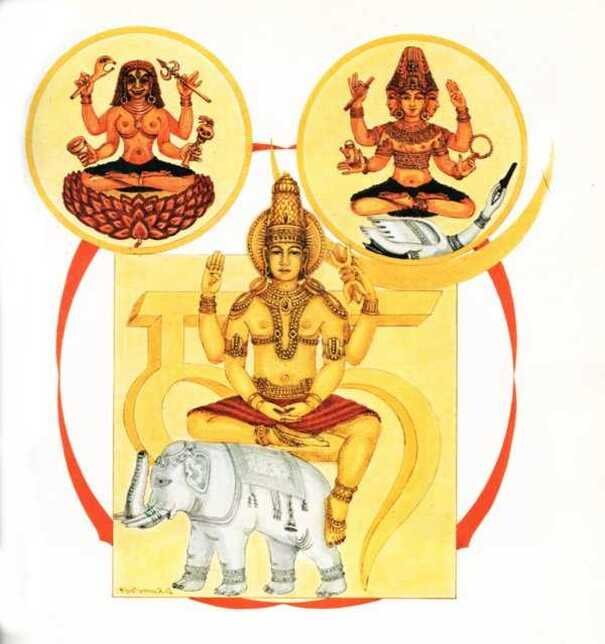
Indra is associated with strength and control over the physical realm, relating to the grounding nature of Muladhara. Indra is yellow in colour, four-armed, holding a thunderbolt and a blue lotus in his hands, mounted on the white elephant Airawata. He is the Hindu god of lightning, thunder, rains and river flows, and king of the gods and heaven (similar to Zeus or Thor). Indra represents the aspect of our mind that indulges in the five senses and also obtains mastery over the five senses.
Brahma is the Hindu god of creation. Brahma is young, deep red, with four-faces, three-eyes, and four-arms, holding a staff, a sacred water-pot, and a rosary of rudraksha (sacred seeds coming from the words Rudra [Shiva] and aksha [eyes]). The fourth hand makes the gesture of dispelling fear. He is seated on a swan. His four heads represent physical self, rational self, emotional self and intuitive self.
Dakini is the feminine principle or activating power and energy. The Dakini is shining red or shining white in colour; she has beautiful face with three eyes; four-armed, holding a trident, a skulled staff, a swan and a drinking vessel; seated on a red lotus.
Symbolism in Muladhara
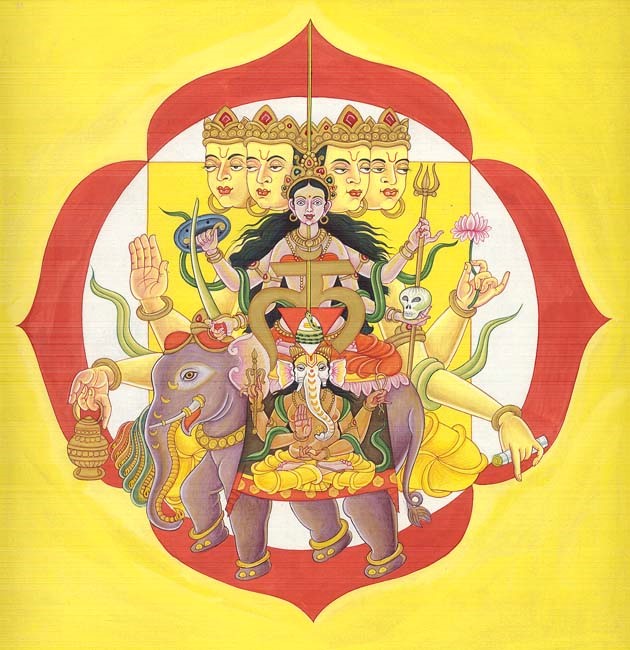
- Red colour petals indicate the colour of Shakti. It means energy, movement, awakening and development. Additionally, it symbolizes awakening the sleeping consciousness to active, alert consciousness.
- The yellow square indicates the earth element, representing the beginning of life. When awakened it manifests as a magnetic force within that person. The bija mantra embedded in the earth element is Lam
- The inverted red triangle indicates female energy (Shakti) of the universe. It also represents the joining of the 3 nadis, ida, pingala and sushumna. Cosmic energy is drawn in & guided downwards, like a funnel to the earth, with an upward expansion of consciousness.
- Lingam within the triangle indicates male gender (Shiva). The lingam has three and a half coiled-serpent lying dormant (the state of ignorance). These three coils represent the three gunas: sattva (goodness), rajas (active), & tamas (laziness), half a coil represents human transcendence by kundalini. The serpent’s head is laid downward in sleep, showing dormant kundalini. When one starts to work with this chakra, the head rises and the energy flows upward through the sushumna nadi.
- Kundalini, supremely subtle, lightning-like splendour; also shining red, white and black (or dark green) colour; three and a half coils around Swayambhu-linga
- Muladhara chakra has a white elephant named Airawata with seven trunks. 7 is a very magical number. It is deeply spiritual, a number of completeness and perfection.
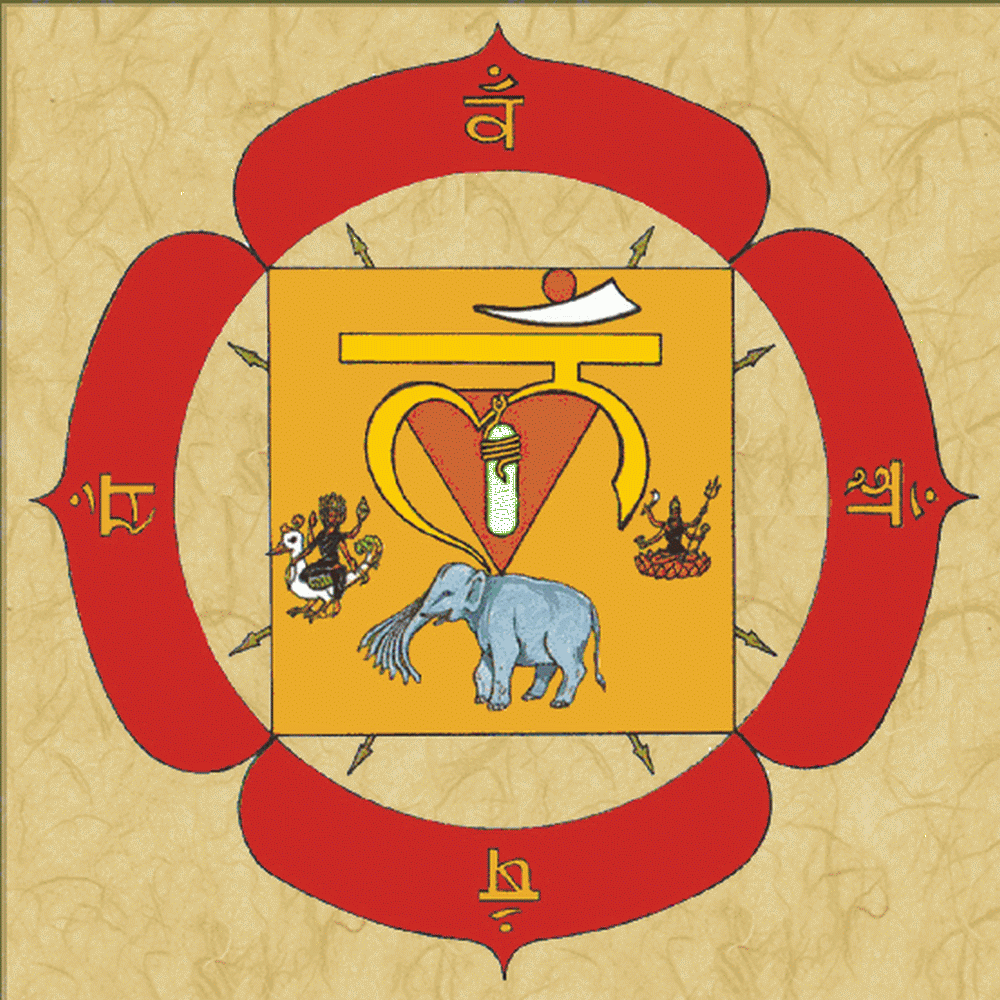
The Eight Right Ways of Living
The yellow square is surrounded by eight shining spears; beautiful, like lightning facing the eight directions of the compass. The Eight Spears point to the 8 right ways of living. The teachings of Buddha were based around the right ways of living, pointing us in the direction of universal love and compassion for all living beings. The Buddha gave his teaching “for the good of the many, for the happiness of the many, from compassion for the world.”
- Right Speech: To speak truthfully, with compassion and love without selfishness
- Right Effort: To Develop a good and wholesome mind and prevent bad states of mind from arising. Practicing the Noble Eightfold Path to lead a pure and spiritual life is the definition of Right Effort
- Right Action: Behave a good and wholesome way. Behaving in a fearless manner with confidence and without anxiety.
- Right View: is seeing things as they really are, impermanent and connected to all other things. Overcoming the obstacle of perception, learning that who perceives and what they perceive are one.
- Right thought: our thoughts mould our nature and direct on what path we should follow. We need to develop wisdom as well as spirituality
- right livelihood: Make your living by choosing a good profession that doesn’t do harm and enriches society. A harmful occupation includes the arms trade and lethal weapons, intoxicating drinks or poisons, killing animals, cheating, etc
- right mindfulness or meditation: Is effortlessly being aware of the present moment
- right Samadhi: living effortlessly for the good of all beings
The Vrittis of Maladhara
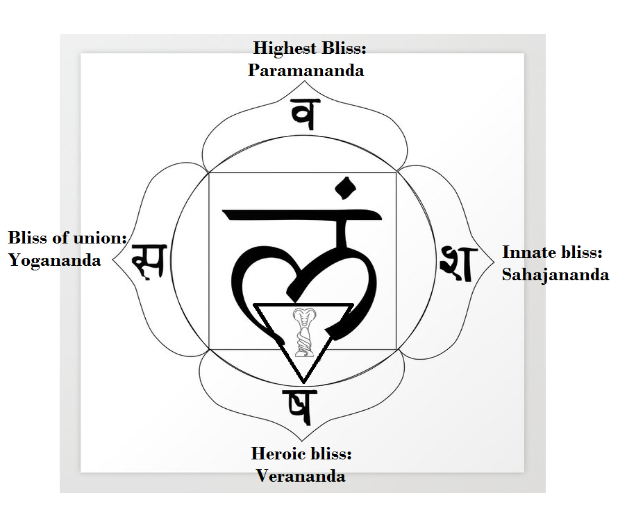
Muladhara has four red or vermilion petals and each petal contains one of the four basic longings in life: Moksa: Spiritual Emancipation, enlightenment, liberation, and release Artha: Wealth. The meaning, sense, goal, purpose or essence of life Kama: Physical. Sensory enjoyment, emotional attraction and aesthetic pleasure such as from arts, dance, music, painting, sculpture and nature. Dharma: Duty. Virtues and “right way of living”, include duties, laws, conduct.
Vritti means “whirlpool,” the contents of mental awareness or disturbances in the medium of consciousness. The mind is a flow or vibration of energy which is an expression of the dynamic flow of the cosmos. In order to express this flow, the mind adopts vrittis, or methods of expression (mental tendencies). To attain enlightenment a yogi must still the vrittis in meditation to reach Samadi, or bliss. Mind has strengthened when the Vrittis (thought-waves) are calmed; however, it is not easy to calm vrittis.
Four red petals of Muladhara indicate there are four nadis in this energy center, they are Ida, Pingala and Shushumna Nadi, the fourth represents the downward movement of energy. When you are meditating you can imagine a golden cord connecting Muladhara chakra with a shining sun deep within the earth’s core.
Each petal has one Sanskrit letter: va ( वं ), scha ( शं ), sha ( षं ), and sa ( सं ) and one specific quality or vritti.
The centre symbol, or bija mantra of the Earth Element is LAM. Bija mantras are sounds endowed with great spiritual powers. They work in the unseen planes of the universe and work out miracles in a profound way. Activation of the elements leads to quicker awakening of Kundalini.
The four vrittis associated with Muladhara Chakra
1. va( वं ) Highest Bliss: Paramananda: Greatest Joy pure spiritual yearning, desire for absolute liberation. Bliss of the divine union in meditation. The state of supreme bliss is reached through evenness of the mind with reference to all aspects of one’s life. 2. scha ( शं ) Innate bliss: Sahajananda: natural pleasure. Wealth. artha: desire for intellectual pleasure, meaning, sense, goal, purpose or essence of life. Wealth brings only temporary satisfaction of worldly desires.
3. sha( षं ) Heroic bliss: Virananda: delight in controlling passion, Kama: desire for physical pleasure: there are four basic physical desires or instincts: life (fear of dying), sex, food and sleep. Kama means all types of physical longings – wealth, opulence, name, fame and social position, as well as sex. None of these limited things can satisfy our infinite desires, so it is wise to moderate our desires and take the Supreme as our ultimate goal.
4. sa ( सं ) Bliss of union: Yogananda dharma: desire for God. psycho-spiritual longing. Blissfulness in concentration “Divine bliss through union (yoga) with God,” or “Divine bliss through the practice of yoga techniques for achieving union.” … The highest state of divine ecstasy is revealed as ineffable bliss— “beyond imagination of expectancy,” [Paramahansa Yogananda]
The Vayu
Apana Vayu
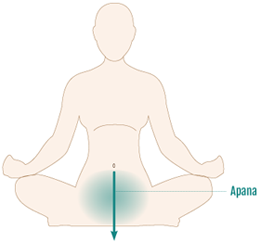
Muladhara chakra governs the vital breath Apana.
Apana vayu governs the movement of energy from the navel down to the pelvic floor or root chakra at the base of the spine.
Apana vayu is responsible for elimination. It moves down and out and also helps retain things in. It governs the elimination of urine, poop, semen, menstrual fluid, and childbirth.
It is activated by the outward breath and expels carbon dioxide.
On a deeper level, it rules the elimination of negative sensory, emotional, and mental experiences.
Some techniques to keep Apan Vayu healthy are:
· Pelvic floor exercises
· Seated yoga asanas
· Apana breathing focuses on exhalation and suspension of breath (holding after exhale)
1. As you inhale, pull the energy into the belly.
2. As you exhale, direct the energy from the belly into the feet/ground.
3. Hold the air out for a moment with attention at the root chakra. Visualize Prana moving down through the legs and out through the feet.
4. Draw vitality up from the earth as you inhale, exhale as you let go of any difficult thoughts or memories.
Repeat for as long as you feel comfortable.
New Age meaning and symbolism
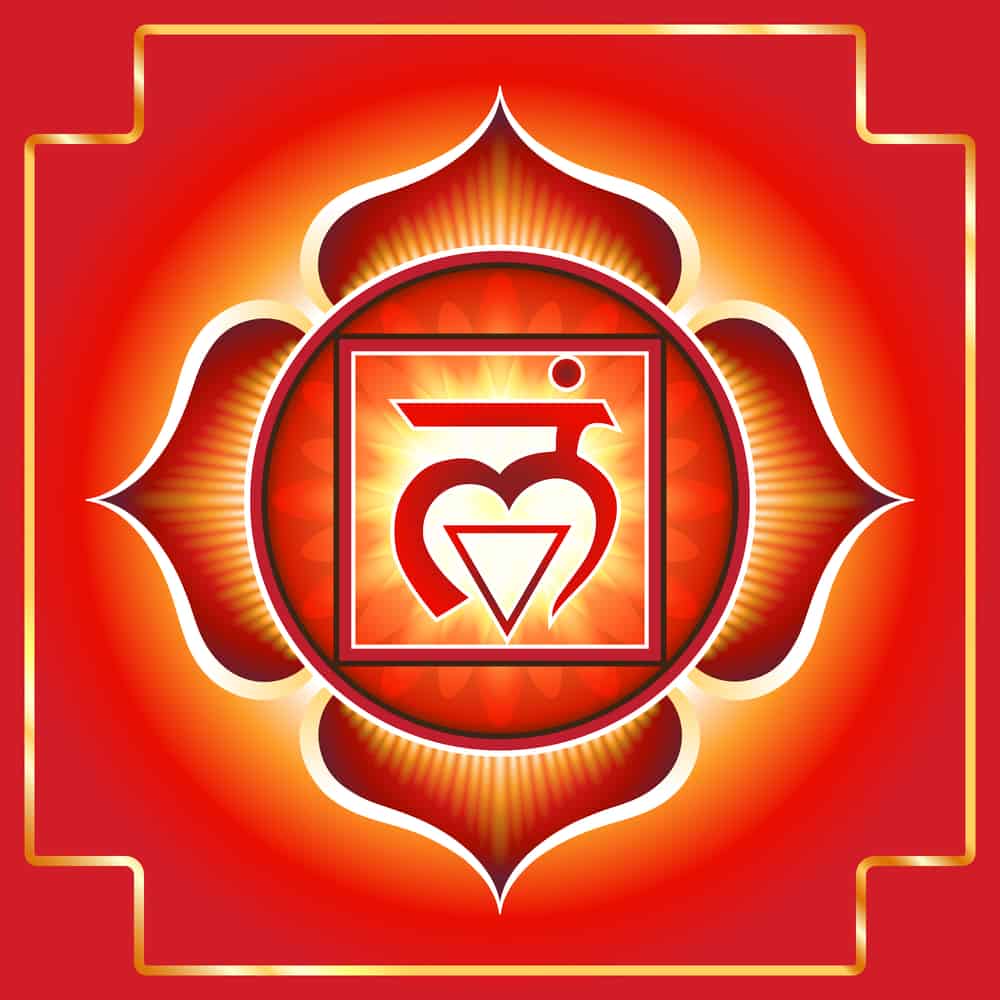
- Its element is Earth
- The colour is red
- It is associated with our sense of smell
- The bija mantra is LAM (The bija mantra of the Earth element is LAM)
- Its symbol is 4 red petals, a yellow square and a downward pointing triangle
- The opposing force of Muladhara chakra is fear – (installed in the chakra by Carl Jung)
Aptly, this energy centre is associated with your root issues, such as your sense of security, satisfying your basic needs, familial relationships, and how at home you feel in your body and on this planet.
Working with the root chakra will bring to light both our positive, uplifting and negative destructive qualities. Yoga clears our minds, so our actions are not directed by how we subconsciously perceive things through past experiences.
The base chakra is all about our physical survival. There are four basic physical desires or instincts: for life (fear of dying), for sex, for food and for sleep.
Deities in Muladhara
Ganesh: Represents wisdom, prosperity, and the removal of obstacles. He is often invoked at the beginning of new ventures. Hanuman: Symbolizes strength, devotion, and unwavering faith. His presence inspires courage and perseverance.
Kubera: The god of wealth, he is associated with abundance and financial stability, reminding devotees of responsible prosperity. Kartikeya: A warrior deity, he embodies determination, discipline, and the triumph of good over evil. Each of these deities is linked to the Muladhara Chakra, which governs security, survival, and foundational energy. Their presence in spiritual practice helps individuals cultivate resilience, balance, and inner strength.
Muladhara is connected to the adrenal glands. It initiates our fight, flight or freeze response.
A balanced root chakra brings emotional stability and the sense of being able to cope with whatever the universe throws your way. It has a feeling of being grounded, yet free as a bird. It gives you compassion and patience towards yourself and others.
If your Root Chakra needs balancing connect with the earth and those you love. Do gardening, go out in nature, walk through the bush, feel the energy in trees be aware of the pull of gravity grounding you to the earth. Connecting with your environment will help you feel balanced and safe, at peace with who you are and your life.
Let go of the material world and connect with your inner self. Practice meditation and yoga. Let your awareness of what truly matters be your guide when you make decisions without the feelings of restlessness, frustration and aggression.
One of the key elements in healing Muladhara chakra is to learn to trust and love yourself and to let go of fear. Nurture your self-confidence, believe that you are important and valuable in this world. You can manifest whatever you conceive in your mind.
As you work on balancing Root chakra you will notice a feeling of optimism, trust, confidence and vitality grow stronger day by day.